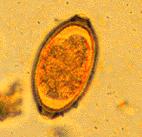Difference between revisions of "Capillaria"
Jump to navigation
Jump to search
| Line 15: | Line 15: | ||
=Overview= | =Overview= | ||
[[Image:Capilaria.jpg|thumb|right|150px|''Capillaria'' - Courtesy of the Laboratory of Parasitology, University of Pennsylvania School of Veterinary Medicine]] | [[Image:Capilaria.jpg|thumb|right|150px|''Capillaria'' - Courtesy of the Laboratory of Parasitology, University of Pennsylvania School of Veterinary Medicine]] | ||
| − | ''Capillaria spp.'' are similar to other members of the Trichuroidea superfamily such as ''Trichuris'' but with slight differences in morphology of the anterior and posterior ends. Although they are found in domestic mammals these species are of greatest importance in birds. | + | ''Capillaria spp.'' are similar to other members of the Trichuroidea superfamily such as ''Trichuris'' but with slight differences in morphology of the anterior and posterior ends. Although they are found in domestic mammals these species are of greatest importance in birds. The predilection sites vary between species and are not restricted to the gastrointestinal system. Important species include; ''C. annulata'', ''C. anatis'' and ''C. contorta''. |
*Similar to ''Trichuris'', but the difference between anterior and posterior ends of the body is not so pronounced | *Similar to ''Trichuris'', but the difference between anterior and posterior ends of the body is not so pronounced | ||
| Line 23: | Line 23: | ||
=Identification= | =Identification= | ||
| − | + | Capillaria are extremely thin, filamentous worms measuring 15-25mm long in males and 35-80mm long in females. Males have a single spicule and a primitive bursa like structure | |
*''Capillaria aerophila'' in [[Respiratory Parasitic Infections - Pathology#Capillaria aerophila|respiratory disease]] of cats and dogs[[Category:Trichinelloidea]] | *''Capillaria aerophila'' in [[Respiratory Parasitic Infections - Pathology#Capillaria aerophila|respiratory disease]] of cats and dogs[[Category:Trichinelloidea]] | ||
Revision as of 21:10, 28 July 2010
| Capillaria spp. | |
|---|---|
| Kingdom | Animalia |
| Phylum | Nematoda |
| Class | Adenophorea |
| Sub-class | Enoplia |
| Order | Trichurida |
| Super-family | Trichuroidea |
| Family | Trichinellidae |
| Genus | Capillaria |
| Species | Many |
Overview
Capillaria spp. are similar to other members of the Trichuroidea superfamily such as Trichuris but with slight differences in morphology of the anterior and posterior ends. Although they are found in domestic mammals these species are of greatest importance in birds. The predilection sites vary between species and are not restricted to the gastrointestinal system. Important species include; C. annulata, C. anatis and C. contorta.
- Similar to Trichuris, but the difference between anterior and posterior ends of the body is not so pronounced
- Some species have direct life-cycles, others use intermediate or transport hosts
- Species have different predilection sites
- Of greatest importance in birds, although species do occur in the urinary bladder and liver of cats and dogs
Identification
Capillaria are extremely thin, filamentous worms measuring 15-25mm long in males and 35-80mm long in females. Males have a single spicule and a primitive bursa like structure
- Capillaria aerophila in respiratory disease of cats and dogs
- In nasal passages, sinuses, trachea and bronchi of cats and dogs
- Some dogs cough but often no symptoms
- Mild catharral inflammation
- In heavy infestation may cause obstruction of the lumen of airways and may develop into secondary bronchopneumonia
